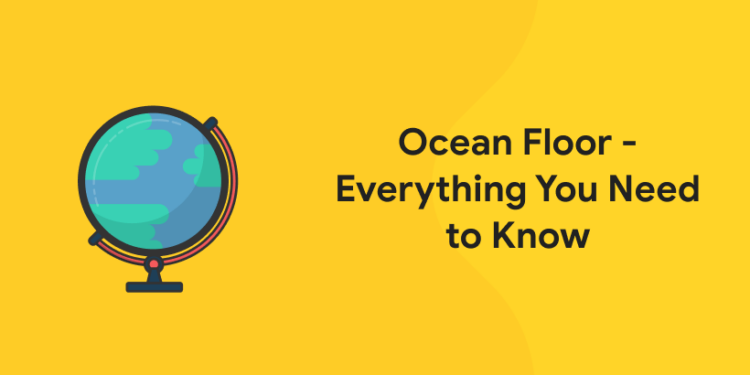Table of Contents
Our planet’s surface is composed of water in its vast majority (71 percent). Almost all of that water—97%—is found in our oceans. This implies, rather counterintuitively, that the vast majority of the topographical characteristics of Earth, such as valleys, plains, and mountains, are also found under water. Let’s “deep dive” into some features\structure of the ocean floor that you should be aware of today.
What Is the Ocean Floor?
The ocean floor is the actual ocean floor. When you dive, you reach the ocean’s bottom. Since diving to the ocean floor requires specialised gear since the water pressure increases as you descend, not many individuals have done it. When you are that far below the surface, you cannot be without protective gear. You would be crushed by the water’s pressure.
Other methods, such as radar, are being used by scientists to investigate the ocean floor. In 2015, the ocean floor was mapped at a resolution of 1.5 kilometres, according to Scientific American. Any object greater than 1.5 kilometres (or 1 mile) can therefore be seen. You could see the canyons, abysses, and slopes of the ocean floor through this mapping.
Life on the Ocean Floor
Most of the ocean floor, in contrast to what you see on land, is lifeless. There isn’t much life in these gloomy waters since sunlight stops entering the ocean floor at a certain depth. Nearer to shore, the ocean floor has coral forests that are home to a wide variety of marine life, including tiny clownfish and sea urchins.
There are king crabs and flounders in different areas of the ocean floor. You can locate mussels and clams with pearls inside them in another area of the ocean.
Download Entri App & prepare for various govt exams.
Structure of Ocean Floor (Ocean Topography)
The subject of topography is the study of landforms. The numerous shapes that the ocean floor might assume are referred to as the topography of the ocean floor. We frequently imagine the ocean floor to be as level and sandy as the beaches we are accustomed to. Thankfully, the ocean floor isn’t exactly that straightforward, predictable, or uninteresting. Despite the fact that the ocean’s bottom is completely covered by water, it is everything but flat, dull, and featureless. We are getting more in-depth views of the ocean floor thanks to maps like the one above. Our capacity to imagine these far-off worlds grows as our technical expertise does.
Continental Shelf
Large land masses called continental shelves encircle each of the continents. Generally speaking, this region is very shallow—less than a few hundred feet. The proportion of continental shelves in all submerged features is about 8%. It’s interesting how the size of continental shelves can vary greatly. For instance, the Siberian continental shelf reaches 1,500 km (930 miles) into the Arctic Ocean. In contrast, the continental shelf off the coast of Africa only reaches 10 km (6 miles) into the Atlantic Ocean.
Additionally, continental shelves act as bulwarks for biological diversity. Around 90% of the fish in the world, according to some estimates, are found along the continental shelf. Even more intriguingly, the majority of algae species and almost all oceanic plants on Earth reside along the continental shelf.
The Bering Strait is one of the oceans’ continental shelves. The hypothetical land bridge that anthropologists, geologists, and climate scientists believe permitted humans to cross over to North America from Asia some 17,000 years ago is backed up by a pile of data. The strait is currently under water, however it is only just submerged. The deepest point is less than 55 metres (180 feet) below the surface.
Attempt Free General Knowledge Mock test! Download Entri App!
Continental Slope
The continental slope is the terminus of the continental shelf. The “seaward boundary of the continental shelf” is how geologists describe this area. Approximately 9% of the entire ocean floor is made up of this water feature. The continental slope of the ocean generally dips into the sea at an angle of 4°. This might not seem like much, but the ocean’s depth will rise by 70 km (43 miles) during the span of 100 km (60 miles) of the continental slope!
While continental slopes have an average grade of fall of 4°, some are substantially higher. The continental slope in Africa drops about 20,000 feet over the course of only 16 kilometres, at a distance of about 1,600 km (1000 miles) from the Cape of Good Hope (10 miles). This is equivalent to an average slope of 70 degrees!
Abyssal Plains
The most prevalent type of terrain on Earth are abyssal plains. They account for 50 percent of the ocean floor. Abyssal plains are described as “extensive, flat, gently sloping or virtually level terrain at abyssal depths” by the International Hydrographic Organization (IHO). Abyssal depths range between 3,000 and 6,000 metres (10,000-20,000 feet). The IHO is not joking when they claim that these plains are flat. Abyssal plains often have a fall of less than 1 metre per 1000 metres, as opposed to continental slopes, which typically have a fall of about 2,800 metres (9,000 feet) for every 1,000 metres (3,000 feet)!
The largest habitat on the planet is the abyssal plains. However, very little is understood about the species that live in this zone. This is primarily caused by the glaring absence of sunshine that reaches these depths. Only about 1,000 metres (3,000 feet) of ocean depth are illuminated by sunlight. Even at the shallowest depth of 3,000 metres, where the abyssal plains are located, the sun never even touches the ground.
Attempt Free General Knowledge Mock test! Download Entri App!
Abyssal Hill
The term “abyssal hill” refers to a group of relatively modest hills that rise from the abyssal plain. A third structure of ocean floor is made up of these characteristics. Typically, they are less than 100 metres (300 feet) wide and climb no higher than a few hundred metres above the abyssal plain.
Seamount
The words sea and mount make up the phrase “seamount,” when broken down. These features are submerged, as indicated by the word “sea” in the title. The word “mount” comes from the word “mountain.” By combining these two, you may define a seamount as an undersea mountain! Seamounts cannot break the water’s surface, which is significant.
Ocean Trench
Trenches are large, uncharted areas of the ocean floor that are located far, far below the surface of the water. The deepest parts of the ocean are found in these underwater canyons. The earth’s surface actually stretches farther below from sea level than it does up! At 8,848 metres, Mount Everest is the highest point on Earth in terms of elevation (29,029 feet). The Mariana Trench, in contrast, extends 11,034 metres (36,201 ft) beneath the surface. The summit of Mount Everest would still be 1.6 kilometres (miles) below the surface if we were to situate it at the bottom of the trench.
Attempt Free General Knowledge Mock test! Download Entri App!
Volcanic Island
Islands is the most popular way to refer to volcanic islands. Islands are seamounts that rise above the water’s surface by definition. In areas like Hawaii, it is possible to watch as lava cools as it hits the ocean and eventually forms new land. An excellent illustration of this is Hawai’i Volcanoes National Park. Although they only make up a small portion of the total area, islands are widespread. It is nearly difficult to calculate the number of islands in the world. Currently, estimates for oceanic islands range from 5,000 to over 100,000. Over geologic time, this number has also changed. Islands are notoriously fragile, and when sea levels change over millions of years, some islands become exposed while others remain covered.
Grab Latest GK Study Materials! Register Here!
I hope you found this article useful. The secret to clearing an exam is to prepare methodically and strategically. If you’re a candidate looking to start your dream job but don’t know where to start, our Entri app has you covered. Our staff will provide you with content and insights on the topics that affect you. Become a member of our app today and enroll in one of the many programs available. Stay up to date on various elements of the subject you’re interested in by using the app. Please feel free to leave any questions or concerns in the comments area. We will make every effort to reach back. Remove any self-doubts and negative thoughts from your mind. Make an effort to maintain a clear viewpoint. Consider why you desire this. Concentrate on the positive aspects of your situation and work diligently. Each day is a valuable gift that has been placed upon us, so make the most of it. Make an effort to improve yourself. Today is the day; let’s hope it goes well. Best wishes.














